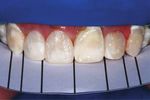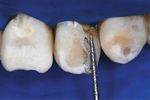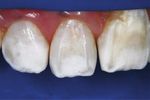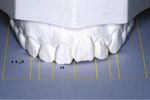Case Report Cleidocranial Dysplasia Case Report: Remodeling of Teeth as Aesthetic Restorative Treatment - FGM
←
→
Page content transcription
If your browser does not render page correctly, please read the page content below
Hindawi Publishing Corporation
Case Reports in Dentistry
Volume 2014, Article ID 901071, 6 pages
http://dx.doi.org/10.1155/2014/901071
Case Report
Cleidocranial Dysplasia Case Report: Remodeling of Teeth as
Aesthetic Restorative Treatment
Leonardo Fernandes da Cunha,1 Isabela Maria Caetano,2 Fernando Dalitz,1 Carla Castiglia
Gonzaga,1 and José Mondelli3
1
Graduate Program in Dentistry, Positivo University, 5300 Rua Professor Pedro Viriato Parigot de Souza, 81280-330 Curitiba, PR,
Brazil
2
Department of Orthodontics, Hospital for Rehabilitation of Craniofacial Anomalies, University of São Paulo, Al. Octávio Pinheiro
Brisolla 9-75, Vila Universitária, 17012-901 Bauru, SP, Brazil
3
University of São Paulo, Bauru, Al. Octávio Pinheiro Brisolla 9-75, Vila Universitária, 17012-901 Bauru, SP, Brazil
Correspondence should be addressed to Leonardo Fernandes da Cunha; cunha leo@yahoo.com.br
Received 17 March 2014; Accepted 5 June 2014; Published 16 June 2014
Academic Editor: Alberto C. B. Delbem
Copyright © 2014 Leonardo Fernandes da Cunha et al. This is an open access article distributed under the Creative Commons
Attribution License, which permits unrestricted use, distribution, and reproduction in any medium, provided the original work is
properly cited.
Cleidocranial dysplasia (CCD), is an autosomal dominant disorder with a prevalence of 1 in 1,000,000 individuals. It is generally
characterized by orofacial manifestations, including enamel hypoplasia, retained primary teeth, and impacted permanent and
supernumerary teeth. The successful treatment involving a timing intervention (orthodontic- maxillofacial surgeons-restorative) is
already described. However, the restorative treatment might improve the aesthetic final result in dentistry management for patients
with cleidocranial dysplasia. Objective. Therefore, this clinical report presents a conservative restorative management (enamel
microabrasion, dental bleaching, and direct composite resin) for aesthetic solution for a patient with CCD. Clinical Considerations.
The cosmetic remodeling is a conservative, secure, and low cost therapy that can be associated with other procedures such as enamel
microabrasion and dental bleaching to achieve optimal outcome. Additionally, the Golden Proportion can be used to guide dental
remodeling to improve the harmony of the smile and the facial composition. Conclusions. Thus, dentists must know and be able to
treat dental aesthetic problems in cleidocranial dysplasia patients. The intention of this paper is to describe a restorative approach
with the cosmetic remodeling teeth (by grinding or addicting material) associated with enamel microabrasion and dental bleaching
to reestablish the form, shape, and color of smile for patients with cleidocranial dysplasia.
1. Introduction dental arch. In these circumstances, restorative intervention
probably improves the final results.
Cleidocranial dysplasia (CCD) is a rare (1 : 1.000.000) auto- Enamel hypoplasia can be thoroughly treated by the
somal dominant inheritance skeletal syndrome related to abrasive action of a microabrasion with pumice and acid
numerous dental abnormalities such as delayed eruption, solutions as described by Croll and Cavanaugh [6, 7]. In
retention of the permanent dentition, and highly arched addition, bleaching is a conservative procedure routinely
palate [1]. Multidisciplinary cooperation between orthodon- used. The association of these techniques is possible and
tists and oral and maxillofacial surgeons is previously a particularly interesting option to other more invasive
described in the literature for treatment of the CCD [2– aesthetic procedures in esthetic improvement of patients with
5]. Nevertheless, in some situations, the orthodontic and enamel hypoplasia and/or CCD.
maxillofacial surgeons’ intervention is not sufficient to meet Besides, when supernumerary teeth and dental anomalies
the patient’s smile aesthetic expectations due to, for example, of size and/or shape are present, other aesthetic treatments are
the presence of enamel hypoplasia or supernumerary teeth in required. In such situations, remodeling of teeth by grinding
can be considered a safe procedure to contour a tooth surface2 Case Reports in Dentistry
(a) (b)
Figure 1: Preoperative view of patient’s smile with cleidocranial dysplasia before orthodontic treatment.
Figure 2: Preoperative view of patient’s smile with cleidocranial Figure 4: After rubber dam placement, application of the
dysplasia after orthodontic treatment. microabrasive product on the surface of the stained enamel with
intermittent appliance.
Figure 3: Close-up view of the anterior teeth after orthodontic treat-
ment. Note the compromised aesthetics due to enamel hypoplasia
and anatomic discrepancies of form, shape, and color. Figure 5: After application of hydrogen peroxide gel on the surface
of the anterior teeth in agreement with the immediate bleaching
procedure, remodeling by grinding of the supernumerary enamel’s
surface with 3203# bur.
or as an adjunct procedure during orthodontic or restorative
treatments [8–11]. It is a conservative method since tooth
reduction can be controlled and adequate improvement in
the aesthetics and function is produced immediately with low The remodeling of teeth is also done by adding restorative
cost. material. The adhesive system and layering technique with
The grinding process must not be done without restora- composite resin can enhance better anatomic form, shape,
tive planning. The Golden Proportion indicated by Levin and and color [14] with minimal invasive procedures. With
Lombardi has been suggested as one potential mathematic the improvement of the adhesive restorative materials, the
method to transmit harmonious dental composition [12, successful aesthetic and stability result of this technique has
13]. This concept of proportion may be used to assist the been advantaged.
remodeling intervention in developing esthetically beautiful Cleidocranial dysplasia is a rare syndrome and these
smile. patients are seeking to improve their dental appearance.Case Reports in Dentistry 3
Figure 6: Dental model for remodeling planning according to “the Figure 10: Close-up view of the anterior teeth after finishing and
Golden Proportion.” polishing the direct adhesive restorations.
Figure 7: Simplified technique for rubber dam placement and acid
etching at restricted points of the enamel surface was performed to Figure 11: The harmony of the dental composition and the smile was
diagnostic mock-up and tissue conditioning. reestablished after remodeling management.
Dentists must be able to solve these situations and an interdis-
ciplinary approach can be an interesting option for achieving
predictable outcomes. Hence, the intention of this paper is to
describe an association of conservative procedures (enamel
microabrasion, dental bleaching, and remodeling of teeth)
as restorative solution for an anterior dental composition
of a patient with cleidocranial dysplasia after cooperation
involving orthodontists and oral and maxillofacial surgeons.
Figure 8: Following the grinding of the upper left central incisor
with diamond disk to improve symmetry across the midline and
tooth discrepancies. 2. Case Presentation
Female patient, 25 years old, with cleidocranial dysplasia,
presented for treatment to the Department of Restora-
tive Dentistry, Bauru School of Dentistry, University of
São Paulo, Brazil. Medical history revealed that orthodon-
tics and maxillofacial surgery were previously involved
(Figures 1(a) and 1(b)). Radiographic images and clinical
exam were made. Clinically, enamel hipoplasia, different
shape, and form were observed in all anterior dental composi-
tion. In addition, the gingival contouring was evaluated and
considered to be not reproducing the harmonious architec-
ture (Figures 2 and 3). However, no periodontal surgery was
done because the gingival margin does not become visible in
Figure 9: Mock-up with composite resin. her smile. This was discussed with the patient and her wish
was respected.4 Case Reports in Dentistry
Initially, microabrasion technique was executed. Glasses 3. Discussion
were used to protect the patient’s and professional’s eyes dur-
ing the operative process, even as rubber dam, to prevent con- The treatment of cleidocranial dysplasia requires multidis-
tact of the product with the gingival tissue. The microabra- ciplinary intervention [2–5]. A restorative approach has an
sive product (Whiteness RM, FGM Produtos Odontológicos imperative role in the final outcome of the treatment because
Ltda., Joinville, Brazil) was applied on the enamel with the existence of enamel hypoplasia or supernumerary teeth
surface irregularities or stains, following the manufacturers’ may disturb the harmony of the smile [12]. In the case
instructions. And so with the aid of a synthetic rubber and presented, either direct resin composite or indirect porcelain
gear reduction angle superficial enamel discoloration was veneers could be performed. However a more conservative
removed after two applications (Figure 4). Water spray was management can be indicated preceding more invasive ther-
applied between each application. apies.
Succeeding, immediate bleach technique was performed Microabrasion and dental bleaching can be considered a
with hydrogen peroxide (Pola Office +, SDI, Victoria, Aus- secure treatment and, furthermore, a conservative alternative
tralia), following the manufacturers’ instructions. The bleach- [17, 18]. Opportunely these treatments can be associated with
ing agent was applied three times on superior and inferior other therapies.
anterior teeth. Dental remodeling was the conduct selected due the
After the microabrasion technique and bleaching treat- advantages offered by this technique. It can be done in a
ment, a remodeling by grinding was performed at the buccal single session, thus contributing to the lower cost of this
face of the supernumerary teeth (Figure 5) and left central procedure when compared to porcelain laminate veneers for
incisor. The ground enamel surfaces were then polished with example. Even extensive recontouring by grinding is also
OptiDisc (Super-Tray, Kerr, Joinville, SC, Brazil). secure, without discomfort or significant pulp and dentin
As a restorative planning, before the remodeling by reactions [9, 10].
adding restorative material, the quantity of space and material According to Snow [19], symmetry across the midline,
needed was evaluated. The restorative planning with supple- anterior or central dominance, and regressive proportion
mentary grinding and the addition of material was executed are three composition elements required to create esthetics
in accordance with the Golden Proportion model (Figure 6). in a smile. The symmetry across the midline guided the
In a subsequent session, according to the restorative interproximal enamel reduction of the left central incisor to
planning, further remodeling by grinding was performed. the elimination of tooth-size discrepancies between upper
Simplified technique for rubber dam placement was used central incisors. As discussed by Harris and Hicks this
[15]. The enamel was removed from the distal surface of the procedure is justified by the little functional significance of
lateral incisors and canines to improve the recurring dental the proximal area [20]. Furthermore, the longevity of this
proportion proceeding distally in the arch [13]. Interproximal reduction by grinding is well documented by Zachrisson
enamel reduction was indicated with diamond bur disk et al., which does not result in iatrogenic damage, such as
(Mani, Kiohara, Japan) in a contra-angle handpiece for elim- gingival problems or dental caries [11]. In addition, regressive
ination of tooth-size discrepancy between central incisors. proportion directed the grinding remodeling of the supernu-
A mock-up restoration to more accurately define color and merary teeth.
shape was previously done before the cosmetic remodeling On the other hand, scientific durability of adhesive system
by addition of material. An acid etching was performed at has been known [21, 22]. Thus, developing form, function,
restricted points of the enamel surface [16] (Figures 7, 8, and and natural aesthetics, it is promising with cosmetic remod-
9). eling by adding restorative material. Deep stains cannot be
Cosmetic remodeling by adding restorative material of removed by enamel microabrasion, even, in association with
the upper anterior teeth was performed by addition of resin an addition of a thin layer of restorative material as can
composite. An etch-and-rinse adhesive system was applied be seen in left lateral incisor. Nevertheless, composite resin
according to the manufacturer’s instructions (OptiBond FL, can be repolished or changed with little preparation of the
Kerr). A nanohybrid resin composite was used (Premisa, tooth surface, therefore preserving tooth structure. In the
Kerr, Brazil). Addition of material was applied to reestablish case presented, a diagnostic mock-up was previously done to
the midline of the central incisors, to correct the morphologic illustrate the possible conclusion of the cosmetic addition of
asymmetry of the supernumerary tooth, and on the upper resin and tissue condition of the gingival margin between the
canines to improve color between the anterior teeth. A thin supernumerary teeth and left upper canine [16, 23].
layer of dentin shade (A2) was firstly inserted to simulate the Since the introduction of the Golden Proportion in
opacity of the dentine, followed by enamel shade (A2). An dentistry by Lombardi [13] and Levin [12], the applications
LED curing light was used (Radii-cal, SDI). of this theory are numerous. Ricketts supported the use of
The final restorative phase was achieved by contour- these Divine Proportion ratios as guides for planning orthog-
ing and finishing the restorations using laminated burs nathic surgery [24], while Furuse et al. suggest the Divine
and sequential discs. The polishing was accomplished Proportion to harmonically allocate spaces between the
with composite polishing paste (Diamond Polishing Paste, anterior teeth for restorative treatment of multiple diastemata
Kerr/Sybron, CA). Final restorations can be observed in [25]. The Golden Proportion also can be used to guide
Figures 10 and 11. dental remodeling by grinding and/or cosmetic remodeling
by adding restorative material. The enamel grinding wasCase Reports in Dentistry 5
performed to harmonically relate the successive width of examples,” Quintessence International, vol. 17, no. 3, pp. 157–164,
the anterior teeth as viewed from the front aspect. At the 1986.
same time, cosmetic remodeling by direct composite resin [8] P. E. Rossouw and A. Tortorella, “A pilot investigation of enamel
established new mesiodistal width for the maxillary central reduction procedures,” Journal of Canadian Dental Association,
incisor. vol. 69, no. 6, pp. 384–388, 2003.
Periodontal aspects before the restorative treatment are [9] A. Thordarson, B. U. Zachrisson, and I. A. Mjör, “Remodeling of
important and must be evaluated [26]. Oral instruction canines to the shape of lateral incisors by grinding: a long-term
and prophylaxis were done before the restorative protocol. clinical and radiographic evaluation,” The American Journal of
Orthodontics and Dentofacial Orthopedics, vol. 100, no. 2, pp.
However, no periodontal surgery was done in the left superior
123–132, 1991.
central incisor because the gingival margin was not visible
[10] B. U. Zachrisson and I. A. Mjör, “Remodeling of teeth by
in her smile. Additionally, root coverage is achieved by many grinding,” The American Journal of Orthodontics, vol. 68, no. 5,
procedures like free gingival autografts. The patient had been pp. 545–553, 1975.
previously submitted to a free gingival autograft in the lower [11] B. U. Zachrisson, L. Nyøygaard, and K. Mobarak, “Dental
right canine. Several studies state that root coverage using health assessed more than 10 years after interproximal enamel
connective tissue grafts has high success rates. However, it reduction of mandibular anterior teeth,” The American Journal
also has disadvantage like less harmonic postoperative color, of Orthodontics and Dentofacial Orthopedics, vol. 131, no. 2, pp.
such as occurred with the patient presented in the lower right 162–169, 2007.
tooth in a previous surgical procedure. Other possibilities [12] E. I. Levin, “Dental esthetics and the golden proportion,” The
were discussed to solve the problem, but the patient preferred Journal of Prosthetic Dentistry, vol. 40, no. 3, pp. 244–252, 1978.
to avoid another surgical procedure. [13] R. E. Lombardi, “The principles of visual perception and
Thus, the cosmetic remodeling teeth (by grinding or their clinical application to denture esthetics,” The Journal of
addicting material) can be a conservative and aesthetic Prosthetic Dentistry, vol. 29, no. 4, pp. 358–382, 1973.
alternative to reestablish the form, shape, and color. The [14] N. Fahl Jr., G. E. Denehy, and R. D. Jackson, “Protocol for
association with techniques such as enamel microabrasion predictable restoration of anterior teeth with composite resins,”
and dental bleaching is possible. And the Golden Proportion Oral Health, vol. 88, no. 8, pp. 15–22, 1998.
can be used to guide dental remodeling to improve the [15] C. R. Wyse, “Simplified technique for rubber dam placement,”
harmony of the smile and the facial composition. Dental Digest, vol. 77, no. 12, pp. 714–717, 1971.
[16] A. Y. Furuse, F. J. Herkrath, E. J. Franco, A. R. Benetti,
and J. Mondelli, “Multidisciplinary management of anterior
Conflict of Interests diastemata: clinical procedures,” Practical Procedures & Aes-
thetic Dentistry, vol. 19, no. 3, pp. 185–192, 2007.
The authors declare that there is no conflict of interests [17] H. M. Elfallah and M. V. Swain, “A review of the effect of vital
regarding the publication of this paper. teeth bleaching on the mechanical properties of tooth enamel,”
The New Zealand Dental Journal, vol. 109, pp. 87–96, 2013.
References [18] K. S. Castro, A. C. de Araújo Ferreira, R. M. Duarte, F. C.
Sampaio, and S. S. Meireles, “Acceptability, efficacy and safety
[1] S. Mundlos, “Cleidocranial dysplasia: clinical and molecular of two treatment protocols for dental fluorosis: a randomized
genetics,” Journal of Medical Genetics, vol. 36, no. 3, pp. 177–182, clinical trial,” Journal of Dentistry, 2014.
1999. [19] S. R. Snow, “Esthetic smile analysis of maxillary anterior tooth
[2] A. Becker, J. Lustmann, and A. Shteyer, “Cleidocranial dysplasia. width: the golden percentage,” Journal of Esthetic Dentistry, vol.
Part 1: general principles of the orthodontic and surgical 11, no. 4, pp. 177–184, 1999.
treatment modality,” The American Journal of Orthodontics and [20] E. F. Harris and J. D. Hicks, “A radiographic assessment of
Dentofacial Orthopedics, vol. 111, no. 1, pp. 28–33, 1997. enamel thickness in human maxillary incisors,” Archives of Oral
Biology, vol. 43, no. 10, pp. 825–831, 1998.
[3] J. Daskalogiannakis, L. Piedade, T. C. Lindholm, G. K. B.
Sándor, and R. P. Carmichael, “Cleidocranial dysplasia: 2 [21] F. F. Demarco, M. B. Corrêa, M. S. Cenci, R. R. Moraes, and N. J.
generations of management,” Journal of the Canadian Dental M. Opdam, “Longevity of posterior composite restorations: not
Association, vol. 72, no. 4, pp. 337–342, 2006. only a matter of materials,” Dental Materials, vol. 28, no. 1, pp.
87–101, 2012.
[4] R. K. Hall and A. L. Hyland, “Combined surgical and orthodon-
[22] J. Krithikadatta, “Clinical effectiveness of contemporary dentin
tic management of the oral abnormalities in children with
bonding agents,” Journal of Conservative Dentistry, vol. 13, pp.
cleidocranial dysplasia,” International Journal of Oral Surgery,
173–183, 2010.
vol. 7, no. 4, pp. 267–273, 1978.
[23] L. Portalier, “Diagnostic use of composite in anterior aesthetics,”
[5] P. T. Smylski, D. G. Woodside, and B. E. Harnett, “Surgical Practical Periodontics and Aesthetic Dentistry, vol. 8, no. 7, pp.
and orthodontic treatment of cleidocranial dysostosis,” Interna- 643–654, 1996.
tional Journal of Oral Surgery, vol. 3, no. 6, pp. 380–385, 1974. [24] R. M. Ricketts, “The biologic significance of the divine propor-
[6] T. P. Croll and R. R. Cavanaugh, “Enamel color modification by tion and Fibonacci series,” The American Journal of Orthodon-
controlled hydrochloric acid-pumice abrasion. I. technique and tics, vol. 81, no. 5, pp. 351–370, 1982.
examples,” Quintessence International, vol. 17, no. 2, pp. 81–87, [25] A. Y. Furuse, E. J. Franco, and J. Mondelli, “Esthetic and
1986. functional restoration for an anterior open occlusal relationship
[7] T. P. Croll and R. R. Cavanaugh, “Enamel color modification with multiple diastemata: a multidisciplinary approach,” Journal
by controlled hydrochloric acid-pumice abrasion. II. Further of Prosthetic Dentistry, vol. 99, no. 2, pp. 91–94, 2008.6 Case Reports in Dentistry
[26] K. L. Knoernschild and S. D. Campbell, “Periodontal tissue
responses after insertion of artificial crowns and fixed partial
dentures,” Journal of Prosthetic Dentistry, vol. 84, no. 5, pp. 492–
498, 2000.You can also read



























































